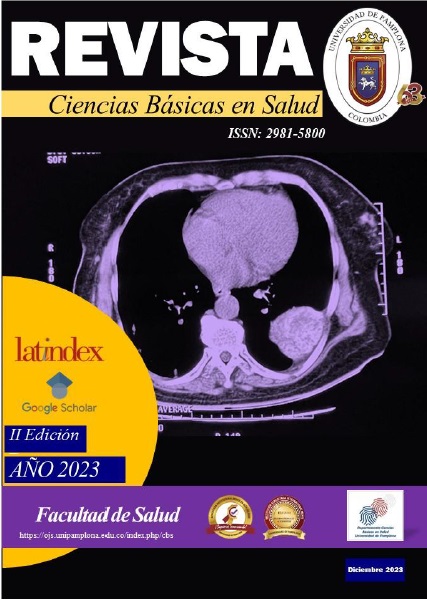Circulación viral causante de infección respiratoria aguda grave confirmada por pruebas múltiple en la E.S.E. Hospital Universitario Erasmo Meoz
DOI:
https://doi.org/10.24054/cbs.v1i2.2634Palabras clave:
Infección Respiratoria Aguda Grave, Virus respiratorios, RT- PCRResumen
Introducción: En el grupo de enfermedades infecciosas, la Infección Respiratoria Aguda (IRA) es la primera causa de morbimortalidad en la población global, los principales agentes causales de IRA comprenden virus como: Sars-CoV-2, Influenza virus tipos A, B y C, Parainfluenza tipos 1, 2, 3 y 4, Virus Sincitial Respiratorio, Coronavirus, Adenovirus, Rhinovirus, Metapneumovirus, Bocavirus y bacterias: Streptococcus pneumoniae y Haemophilus influenzae. La Sociedad Americana de Enfermedades Infecciosas (IDSA) recomienda el uso de pruebas moleculares como la Reacción de cadena polimerasa en tiempo real (rRT-PCR) por encima de otras pruebas, el objetivo del estudio fue caracterizar la circulación en infección respiratoria aguda grave (IRAG) a partir de pruebas diagnósticas moleculares para la detección de siete virus respiratorios: Influenza A, Infuenza A (H3N2), Influenza B, Adenovirus, Metapneumovirus, Sars-CoV-2 y Virus Sincitial Respiratorio (VSR). Materiales y Métodos Estudio descriptivo de corte transversal que incluyó a toda la población que ingresó al Hospital Universitario Erasmo Meoz por Infección Respiratoria Aguda Grave con criterios de hospitalización de manera consecutiva desde el 2021 hasta 2022. La circulación viral fue representada por ciclo vital mensualmente. Se identificó coinfección viral y se realizó emparejamiento para determinar la más común. Resultados Del total de 803 pacientes, se encontró una proporción más alta de IRAG en lactantes del 65% (n=523) con una distribución porcentual similar entre colombianos y migrantes. El siguiente grupo poblacional con mayor proporción fueron los adultos mayores con el 9% de los casos (n=76), teniendo una mayor distribución entre colombianos versus migrantes (11% vs 3%); los Hombres fueron los mayormente afectados, 55% y 54%, respectivamente. El régimen de seguridad social más atendido entre población colombiana fue el subsidiado con el 87% (n=542). Sin embargo, se notaron grandes diferencias en la población migrante en donde predominó el no aseguramiento en el 92% de los casos (n=165); lo cual indica el gran trabajo de responsabilidad social de la institución y la atención con enfoque diferencial. Al determinar los patrones de circulación por ciclo vital, el VSR y el adenovirus fueron especialmente prevalentes en lactantes menores y mayores durante la mayor parte de ambos años, mientras que SARS-CoV-2 en prescolares, escolares, adultos y adultos mayores hacia el final del 2022. Además, se identificaron patrones de coinfección virus-virus, siendo la del VSR y adenovirus las más frecuentes con los demás agentes virales. La mortalidad por IRAG disminuyó de 2.6 a 1.1 por cada 1000 egresos hospitalarios en colombianos y de 1.0 a 0.8 en migrantes entre 2021 y 2022. Conclusiones La RT- PCR Múltiple tiene una gran utilidad en los sistemas de vigilancia epidemiológica ya que permiten documentar patrones de circulación viral en Infecciones Respiratorias Agudas Graves causantes de morbimortalidad en nuestra región y patrones de posible coinfección virus-virus. Los modelos actuales de prevención deben estar dirigidos a pacientes menores de 5 años y mayores de 60 años en donde la posibilidad de hospitalización es mayor. Las edades con mayor reporte de infecciones y coinfecciones pertenecen a los ciclos de vida del lactante mayor y el prescolar, con una gran oportunidad para generar estrategias de reconocimiento temprano y seguimiento.
Descargas
Referencias
Adobe Acrobat. [citado el 26 de julio de 2023]. Disponible en: https://acrobat.adobe.com/link/review?uri=urn%3Aaaid%3Ascds%3AUS%3A438b89c8-e482-3b9f-a3e2-6116be4f7d03
Adobe Acrobat. [citado el 26 de julio de 2023]. Disponible en: https://acrobat.adobe.com/link/review?uri=urn%3Aaaid%3Ascds%3AUS%3Ae8fc7424-bc3a-3f2f-b105-20f31c5610ef
Cebey-López M, Herberg J, Pardo-Seco J, Gómez-Carballa A, Martinón-Torres N, Salas A, et al. Does viral co-infection influence the severity of acute respiratory infection in children? PLoS One [Internet]. 2016 [citado el 13 de noviembre de 2023];11(4): e0152481. Disponible en: http://dx.doi.org/10.1371/journal.pone.0152481
DynaMed. Choice (Middletown) [Internet]. 2012;50(03):50-1497-50–1497. Disponible en: http://dx.doi.org/10.5860/choice.50-1497
Gov.co. [citado el 10 de octubre de 2023]. Disponible en: https://www.minsalud.gov.co/sites/rid/Lists/BibliotecaDigital/RIDE/DE/DIJ/circular-23-de-2017.pdf
Mahony JB. Detection of respiratory viruses by molecular methods. Clin Microbiol Rev [Internet]. 2008 [citado el 26 de julio de 2023];21(4):716–47. Disponible en: http://dx.doi.org/10.1128/CMR.00037-07
Walsh EE, Peterson DR, Falsey AR. Human metapneumovirus infections in adults: another piece of the puzzle: Another piece of the puzzle. Arch Intern Med [Internet]. 2008 [citado el 26 de julio de 2023];168(22):2489–96. Disponible en: https://pubmed.ncbi.nlm.nih.gov/19064834/
Science, Tran D, Smieja M, Merglen A, Mertz D. Clinical disease severity of respiratory viral co-infection versus single viral infection: A systematic review and meta-analysis. PLoS One [Internet]. 2014 [citado el 13 de noviembre de 2023];9(6):e99392. Disponible en: http://dx.doi.org/10.1371/journal.pone.0099392
Descargas
Publicado
Número
Sección
Licencia
Derechos de autor 2023 Revista Ciencias Básicas en Salud

Esta obra está bajo una licencia internacional Creative Commons Atribución-NoComercial 4.0.







